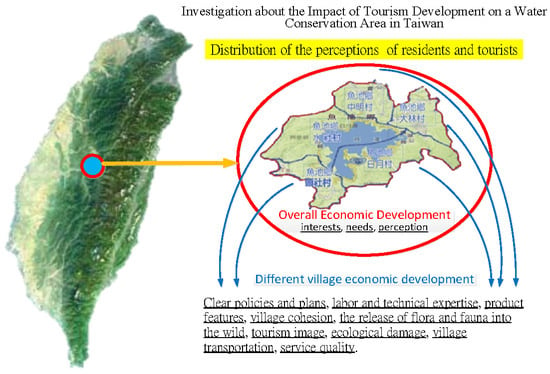Investigation about the Impact of Tourism Development on a Water Conservation Area in Taiwan
Abstract
1. Introduction
1.1. Location of Sun Moon Lake and Its Current State of Tourism Development
1.2. Theoretical Framework for Analyzing Tourism Impacts
1.3. Analysis and Review of Related Studies
2. Methods and Instruments
2.1. Study Framework and Hypotheses
2.2. Study Procedure and Instruments
3. Analysis of Results
3.1. Descriptive Characteristics of the Sample
3.2. Perceptions of Different Stakeholders about Current Tourism Developments in the Sun Moon Lake Area and in Local Villages
3.2.1. Economic Development
3.2.2. Social Development
3.2.3. Environmental Development
4. Conclusions and Recommendations
4.1. Conclusions
4.2. Recommendations
Author Contributions
Acknowledgments
Conflicts of Interest
References
- Ministry of Transportation and Communications. 2016 Annual Survey of Visitors Expenditure and Trends in Taiwan. 2017. Available online: http://admin.taiwan.net.tw/statistics/year.aspx?no=134 (accessed on 22 February 2018).
- Cohen, C.; Regan, T. The Animal Rights Debate; Rowman & Littlefield: Lanham, MD, USA, 2001; p. 336. ISBN 0-8476-9662-6. [Google Scholar]
- Butler, R.W. The concept of a tourist area cycle of evolution: Implications for management of resources. Can. Geogr. 1980, 24, 5–12. [Google Scholar] [CrossRef]
- Taylor, P. Respect for Nature: A Theory of Environmental Ethic. Environ. Ethics 1986, 3, 197–218. [Google Scholar] [CrossRef]
- Ap, J.; Crompton, J.L. Developing and Testing a Tourism Impact Scale. J. Travel Res. 1998, 37, 120–130. [Google Scholar] [CrossRef]
- Gursoy, D.; Jurowski, C.; Uysal, M. Resident Attitudes: A structural modeling approach. Ann. Tour. Res. 2002, 20, 79–105. [Google Scholar] [CrossRef]
- Perdue, R.R.; Long, P.T.; Allen, L. Resident support for tourism developments. Ann. Tour. Res. 1990, 14, 420–429. [Google Scholar] [CrossRef]
- Ealey, A.J.; Snait, E.T.; Miller, G. Social impacts of tourism—A case study of BatE. UK Ann. Tour. Res. 2005, 32, 647–668. [Google Scholar] [CrossRef]
- Ko, D.; Stewart, W.P. A structural equation model of residents’ attitudes for tourism development. Tour. Manag. 2002, 23, 521–530. [Google Scholar] [CrossRef]
- Ministry of Transportation and Communications. Visitors to the Principal Scenic Spots in Taiwan, 2016. 2017. Available online: http://admin.taiwan.net.tw/statistics/year.aspx?no=134 (accessed on 22 February 2018).
- Lankford, S.V.; Howard, D.R. Developing a Tourism Impacts Attitude Scale. Ann. Tour. Res. 1994, 21, 121–139. [Google Scholar] [CrossRef]
- McCool, S.F.; Martin, S.R. Community Attachment and Attitudes toward Tourism Development. J. Travel Res. 1994, 32, 29–34. [Google Scholar] [CrossRef]
- Cuieford, J.P. Fundamental Statistics in Psychology and Education; McGraw-Hill: New York, NY, USA, 1965; ISBN-10 0070251487. [Google Scholar]
- Doxey, G.V. When enough’s enough: The natives are restless in Old Niagara. Heritage Can. 1976, 2, 26–27. [Google Scholar] [CrossRef]
- Nunkoo, R.; Ramkissoon, H. Modeling community support for a proposed integrated resort project. J. Sustain. Tour. 2010, 18, 257–277. [Google Scholar] [CrossRef]
- Zaidan, E.; Kovacs, J.F. Resident attitudes towards tourists and tourism growth: A case study from the Middle East, Dubai in United Arab Emirates. Eur. J. Sustain. Dev. 2017, 6, 291–307. [Google Scholar] [CrossRef]
- De Waal, F.B.M. Are We Smart Enough to Know How Smart Animals Are? W. W. Norton & Company: London, UK, 2017. [Google Scholar]
- Ka-shiang, L. Ring-Necked Bird Pinocha; Yuan-Liou Publishing: Taipei, Taiwan, 1991; p. 256. ISBN 9573212285. [Google Scholar]
- Schreiber, R.L.; Diamond, A.W.; Peterson, R.T.; Cronkite, W. Save the Birds; Cambridge at the University Press: Lanham, MD, USA, 1987; p. 384, ISBN-10 0395511720. [Google Scholar]
- Carmichael, B.A.; Peppard, D.M., Jr.; Boudreau, F.A. Megaresort on my doorstep: Local resident attitudes toward Foxwoods casino and casino gambling on nearby Indian reservation land. J. Travel Res. 1996, 34, 9–16. [Google Scholar] [CrossRef]
- Lawson, R.W.; Williams, J.; Young, T.; Cossens, J. A comparison of residents’ attitudes towards tourism in 10 New Zealand destinations. Tour. Manag. 1998, 19, 247–256. [Google Scholar] [CrossRef]
- Lankford, S.V. Attitudes and perceptions toward tourism and rural regional development. J. Travel Res. 1994, 32, 35–43. [Google Scholar] [CrossRef]
- Jorge, P.E.; Pinto, B.V. Olfactory information from the path is relevant to the homing process of adult pigeons. Behav. Ecol. Sociobiol. 2017, 72, 5. [Google Scholar] [CrossRef]
- Jurowski, C.; Uysal, M.; Williams, D. A theoretical analysis of host community resident reactions to tourism development. J. Travel Res. 1997, 36, 3–11. [Google Scholar] [CrossRef]
- Husbands, W. Social status and perception of tourism in Zambia. Ann. Tour. Res. 1989, 16, 237–253. [Google Scholar] [CrossRef]
- Campón-Cerro, A.M.; Folgado-Fernández, J.A.; Hernández-Mogollón, J.M. Rural Destination Development Based on Olive Oil Tourism: The Impact of Residents’ Community Attachment and Quality of Life on Their Support for Tourism Development. Sustainability 2017, 9, 1624. [Google Scholar] [CrossRef]
- Keogh, B. Public participation in community tourism planning. Ann. Tour. Res. 1990, 17, 449–465. [Google Scholar] [CrossRef]
- Otto, J.E.; Ritchie, J.R.B. The service experience in tourism. Tour. Manag. 1996, 17, 165–174. [Google Scholar] [CrossRef]
- Belisle, F.J.; Hoy, D.R. The Perceived Impact of Tourism by Residents: A Case Study in Santa Marta, Colombia. Ann. Tour. Res. 1980, 7, 83–101. [Google Scholar] [CrossRef]
- Zhang, A.; Zhong, L.; Xu, Y.; Wang, H.; Dang, L. Tourists’ Perception of Haze Pollution and the Potential Impacts on Travel: Reshaping the Features of Tourism Seasonality in Beijing, China. Sustainability 2015, 7, 2397–2414. [Google Scholar] [CrossRef]
- Tsai, K.-T.; Lin, T.-P.; Lin, Y.-H.; Tung, C.-H.; Chiu, Y.-T. The Carbon Impact of International Tourists to an Island Country. Sustainability 2018, 10, 1386. [Google Scholar] [CrossRef]
- Ryan, C.; Huyton, J. Balanda Tourists and Aboriginal People. Ann. Tour. Res. 2002, 29, 631–647. [Google Scholar] [CrossRef]
- Strauss, A.; Corbin, J.M. Basics of Qualitative Research: Grounded Theory Procedures and Techniques; Sage: Newbury Park, CA, USA, 1990; p. 400, ISBN-13 978-1412906449. [Google Scholar]
- Strauss, A.; Corbin, J.M. Basics of Qualitative Research: Grounded Theory Procedures and Techniques, 2nd ed.; Sage: Thousand Oaks, CA, USA, 1998; p. 336. ISSN 1049-7323. [Google Scholar]
- Janesick, V.J. The choreography of qualitative research design: Minuets, improvisations, and crystallization. In Handbook of Qualitative Research; Denzin, N.K., Lincoln, Y.S., Eds.; Sage: Thousand Oaks, CA, USA, 1998; pp. 379–399. [Google Scholar]
- Tuomaala, M.S.; Kurki, P.Å.; Rekiaro, M.; Paavilainen, E. Coping Experiences: A Pathway towards Different Coping Orientations Four and Twelve Months after Myocardial Infarction—A Grounded Theory Approach. Nurs. Res. Pract. 2012, 2012, 674783. [Google Scholar] [CrossRef]
- Ajzen, I. The theory of planned behavior. Organ. Behav. Hum. Decis. Process. 1991, 50, 179–211. [Google Scholar] [CrossRef]
- Teye, V.; Sonmez, S.F.; Sirakaya, E. Residents’ Attitudes towards Tourism Development. Ann. Tour. Res. 2002, 29, 668–688. [Google Scholar] [CrossRef]
- Tai-Yi Associates. Comprehensive Outline Plan for the Tourism Development of Sun Moon Lake National Scenic Area: Final Report; Sun Moon Lake National Scenic Area Administration: Nantou, Taiwan, 2014.
- Haeckel, E. Ueber die Crambessiden, eine neue Meduse-Familie aus der Rhizostomeengruppe. Zeitschrift Für Wissenschaftliche Zoologie 1869, 19, 509–537. [Google Scholar]
- Streubert-Speziale, H.J.; Carpenter, D.R. Qualitative Research in Nursing: Advancing the Human Imperative; Lippincott Williams and Wilkins: London, UK, 2003; p. 470, ISBN-10 0781796008. [Google Scholar]
- Thurow, L.C. The Future of Capitalism: How Today’s Economic Forces Will Shape Tomorrow’s World; Penguin Books: New York, NY, USA, 1998; p. 400, ISBN-10 0140263284. [Google Scholar]
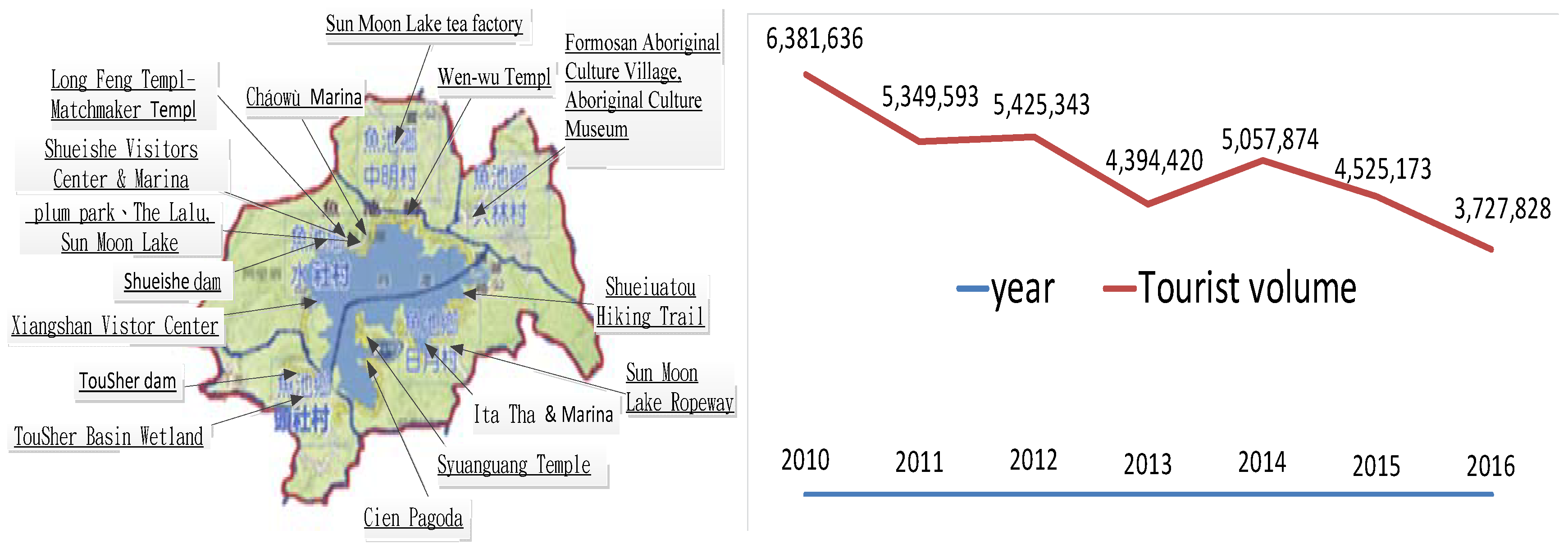
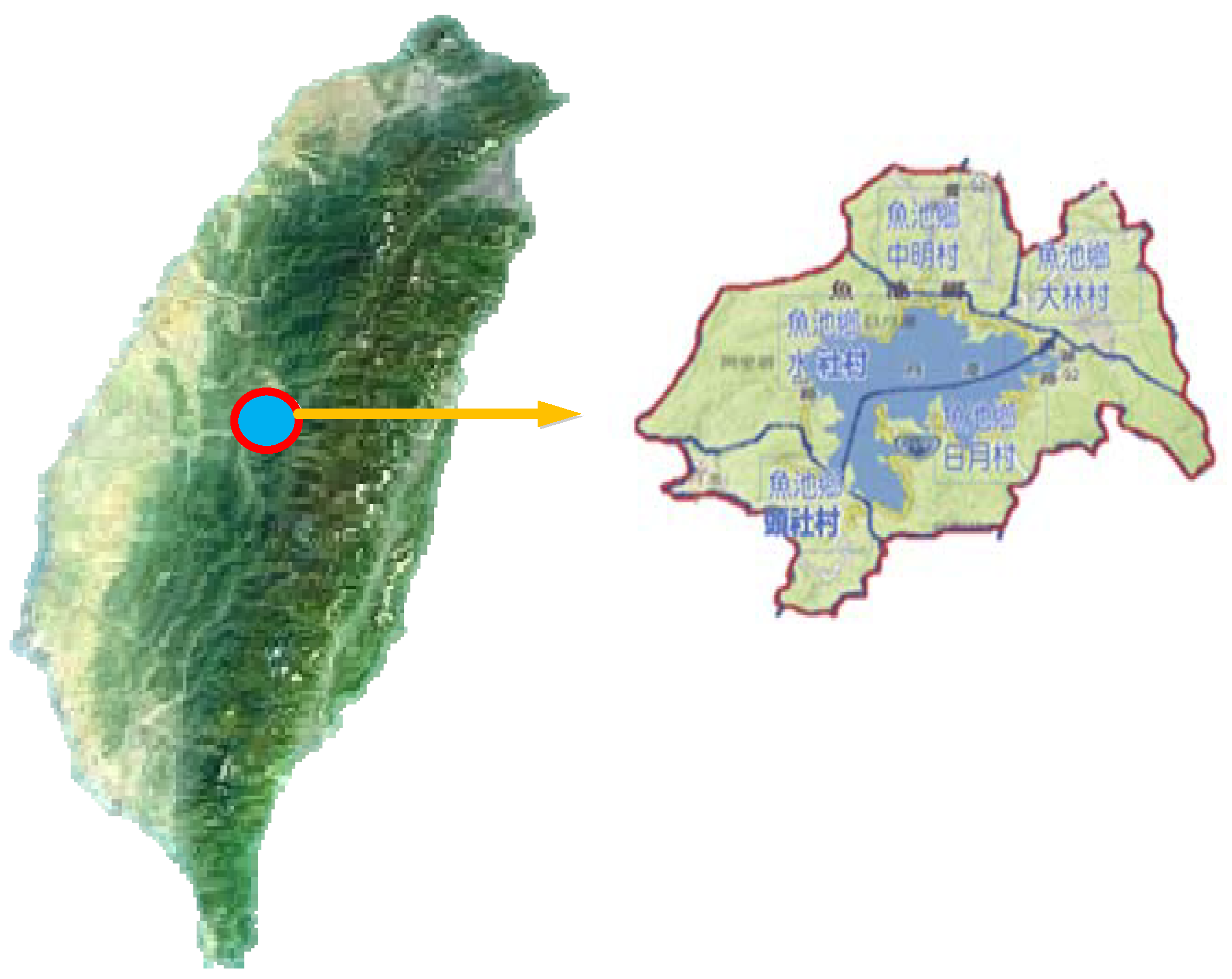
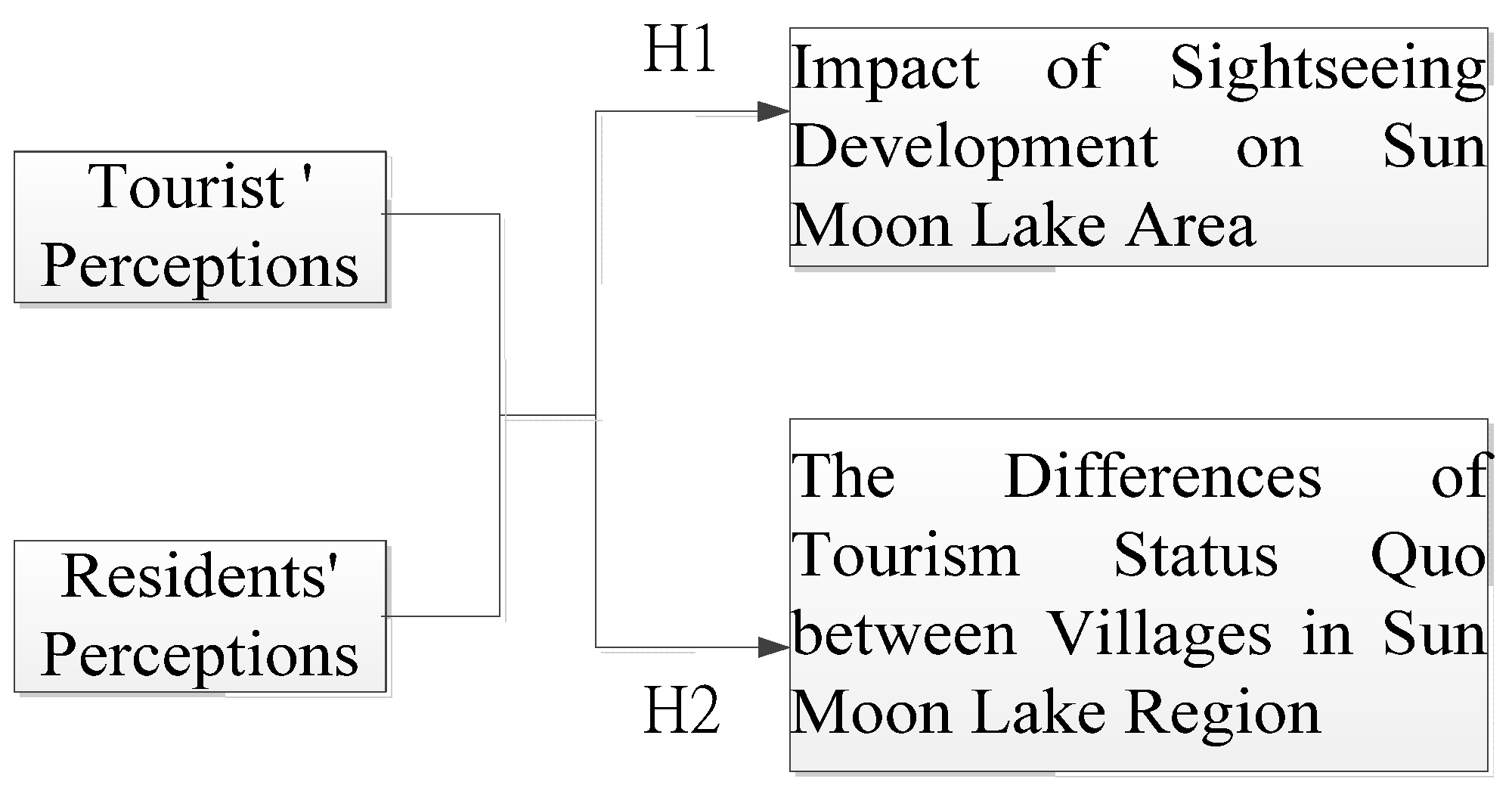
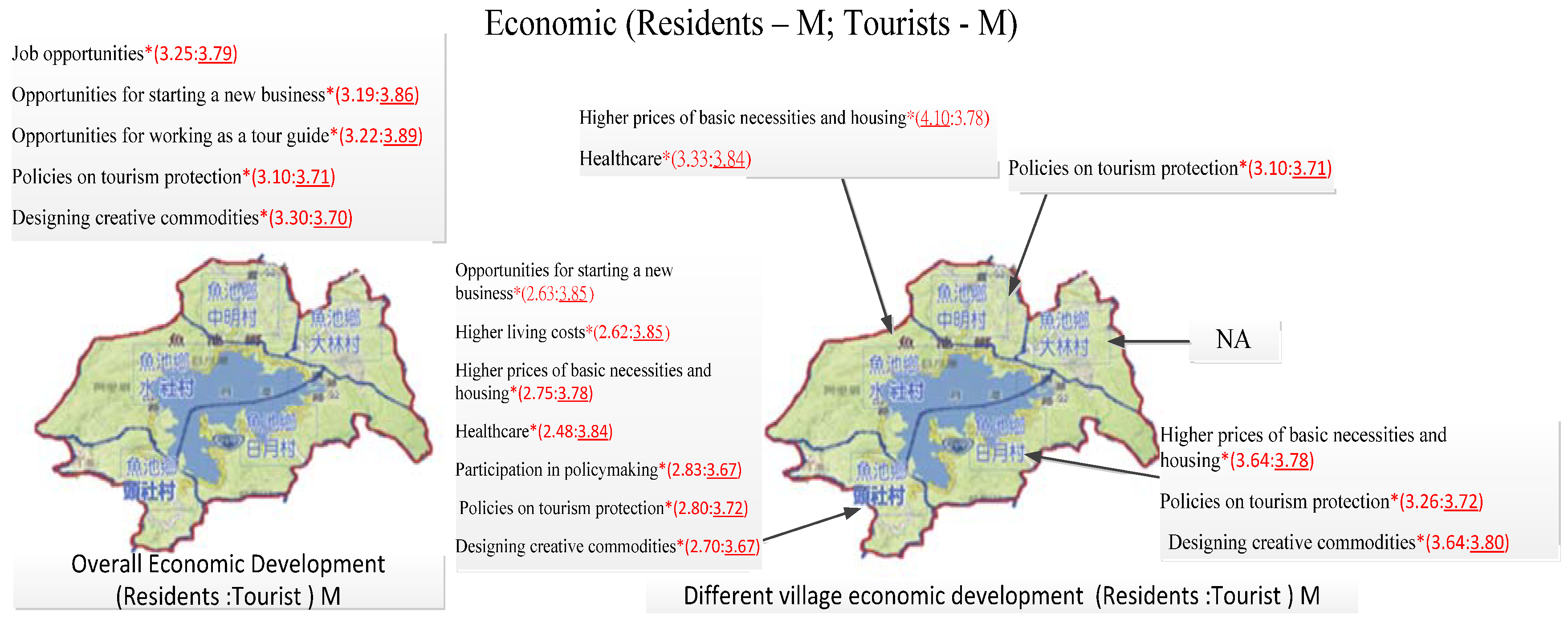
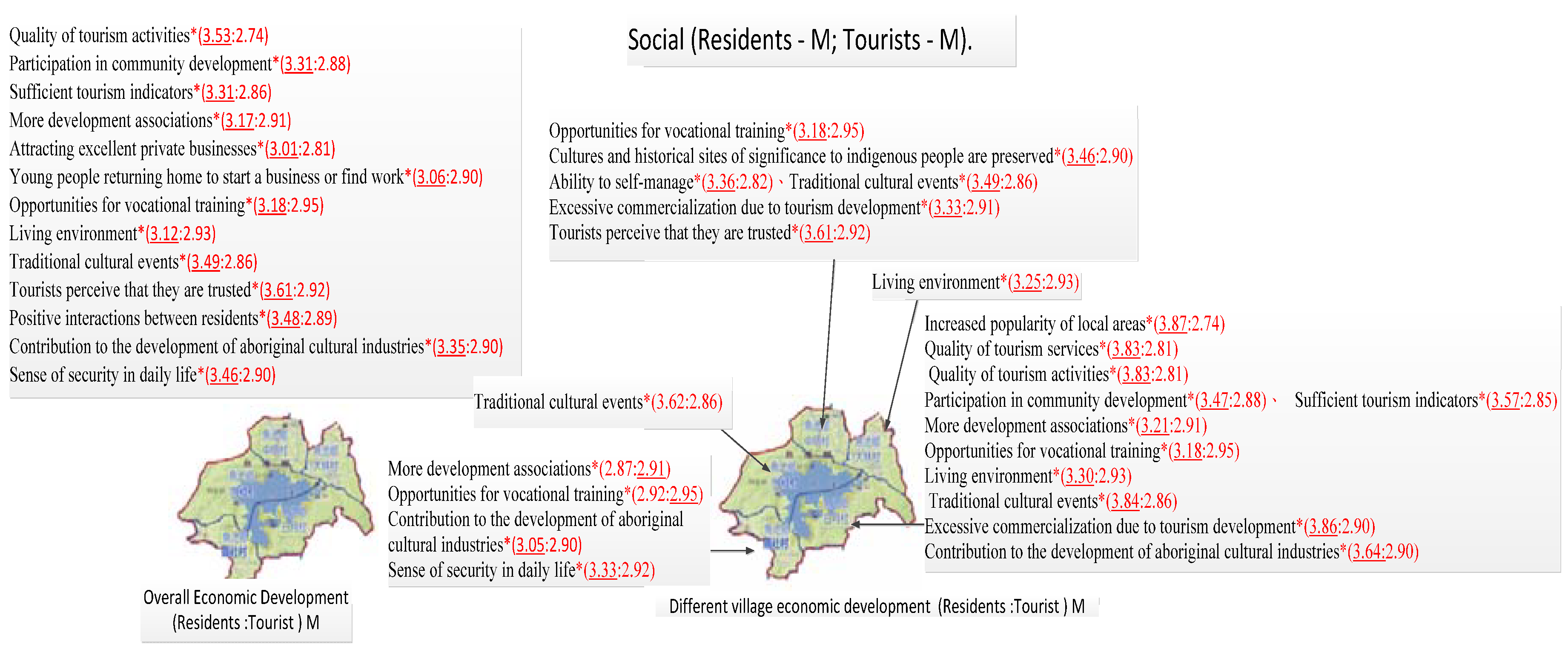
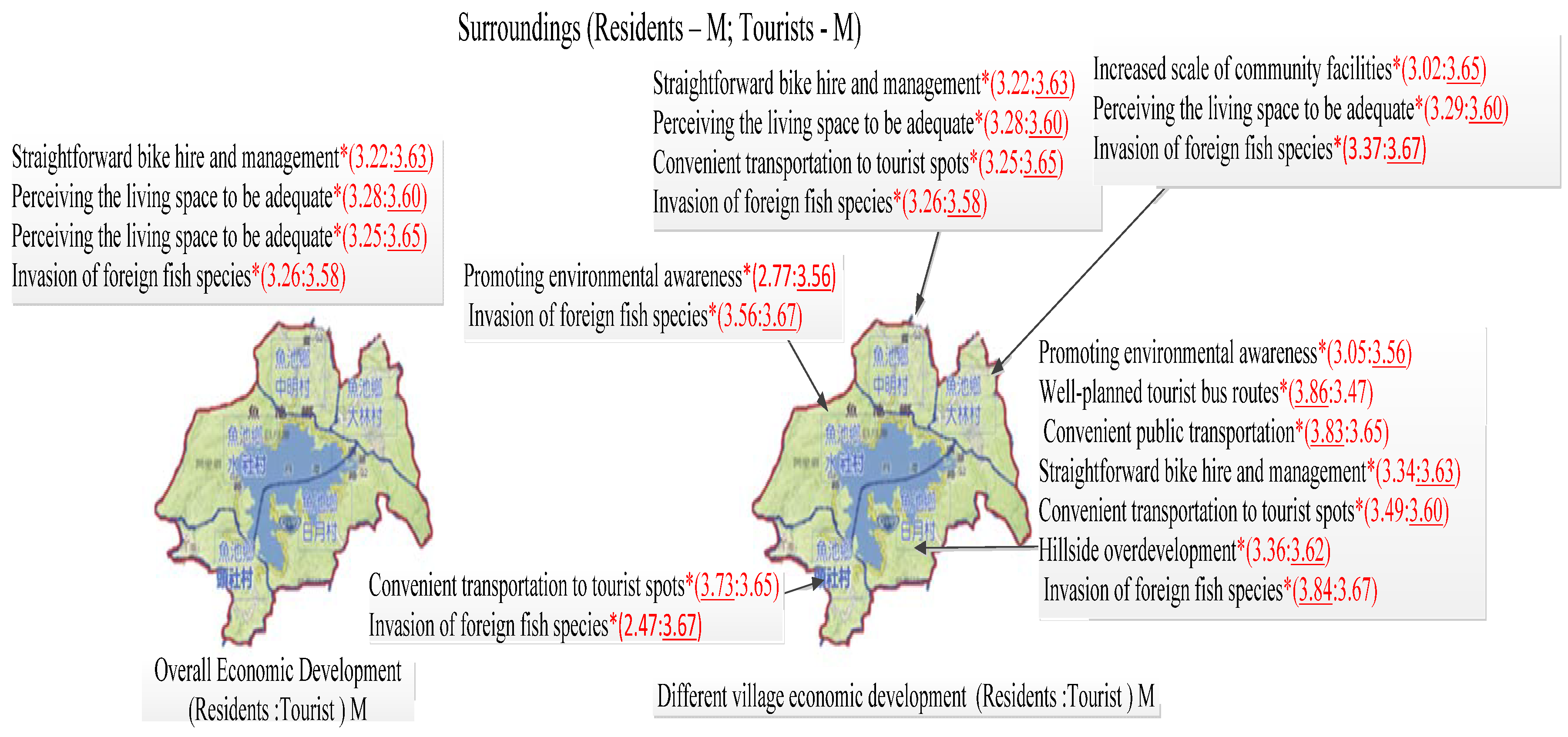
| Construct | Issues of Perceptions about the Impact of Tourism | Cronbach’s α |
|---|---|---|
| Economic (E) | (E1) Job opportunities, (E2) Opportunities for starting a new business, (E3) Earning a satisfactory wage, (E4) Higher living costs, (E5) Tourism infrastructure, (E6) Tourism industry, (E7) Opportunities for working as a tour guide, (E8) Integrating featured industries, (E9) Opportunities for promoting tourism and leisure, (E10) Discounts on the use of recreational facilities, (E11) Public infrastructure, (E12) Contributions from industries, (E13) Higher prices of basic necessities and housing, (E14) Healthcare, (E15) Channels of communication with the government, (E16) Participation in policymaking, (E17) Policies on tourism protection, (E18) Designing creative commodities. | 0.936–0.944 |
| Social (C) | (C1) Increased popularity of local areas, (C2) Quality of tourism services, (C3) Quality of tourism activities, (C4) Participation in community development, (C5) Community maintenance, (C6) Sufficient tourism indicators, (C7) Choice of recreational facilities, (C8) More developmental associations, (C9) Attracting private businesses with good performance, (C10) Young people returning home to start a business or find work, (C11) Opportunities for vocational training, (C12) Private businesses contributing to the local economy, (C13) Living environment, (C14) Cultures and historical sites of significance to indigenous people are preserved, (C15) Ability to self-manage, (C16) Traditional cultural events, (C17) Excessive commercialization due to tourism development, (C18) Tourists perceive that they are trusted, (C19) Positive interactions between residents and tourists, (C20) Contribution to the development of aboriginal cultural industries, (C21) Safety management for tourism activities, (C22) The number of police officers and firefighters, (C23) Sense of security in daily life, (C24) Purchasing lands or properties. | 0.973–0.974 |
| Environmental (S) | (S1) Community environment management, (S2) Promoting environmental awareness, (S3) Preservation of historical sites, (S4) Participation in local conservation work, (S5) Increased environmental literacy among tourists, (S6) Well-planned tourist bus routes, (S7) Consistent wireless Internet connectivity, (S8) Comprehensive network of trails for walking and hiking, (S9) Well-maintained cycling paths, (S10) Convenient public transportation, (S11) The Internet makes life and work efficient, (S12) Straightforward bike hire and management, (S13) Increased scale of community facilities, (S14) Adequate parking spaces, (S15) Tourists have an impact on the natural environment, (S16) Perceiving the living space to be adequate, (S17) Convenient transportation to tourist spots, (S18) Local water sources are polluted, (S19) Good air quality, (S20) Lakes and rivers are polluted, (S21) Hillside overdevelopment, (S22) Local ecological landscape is damaged, (S23) Excessive exhaust fumes from cars and scooters, (S24) Increased noise and waste, (S25) Invasion of foreign fish species | 0.926–0.927 |
| No. | Interview Outline for the Perception of Current Tourism Developments at Sun Moon Lake |
|---|---|
| 01 | What is the biggest impact of increased job opportunities and industrial upgrading (E10, E11, E12, E14, E15, E16, E17, and E18) on the local area? Please provide and explain two or more examples. |
| 02 | What is the biggest impact of policy promotion and implementation (E1, E2, E4, E5, E6, E7, and E8) on the local area? Please provide two or more examples and briefly describe them. |
| 03 | What is the biggest impact of public infrastructure and increased wages (E3, E9, E11, and E13) on the local area? Please provide two or more examples and briefly describe them. |
| 04 | What is the biggest impact of the improved quality of tourism development (C16, C17, C18, C19, C20, C22, C23, and C24) on the local area? Please provide and describe two or more examples. |
| 05 | What is the biggest impact of industrial contributions to the community (C15, C16, C18, C19, C20, C21, C22, C23, and C24) on the local area? Please provide and describe two or more examples. |
| 06 | What is the biggest impact of public security management and cultural preservation (C1, C2, C3, C4, C6, C7, and C15) on the local area? Please provide two or more examples and briefly describe them. |
| 07 | What is the biggest impact of transportation services and Internet communication (S6, S7, S8, S9, S10, S11, and S12) on the local area? Please provide two or more examples and briefly describe them. |
| 08 | What is the biggest impact of man-made pollution and environmental degradation (S20, S21, S22, S23, S24, and S25) on the local area? Please provide two or more examples and briefly describe them. |
| 09 | What is the biggest impact of public participation in environmental conservation (S1, S2, S3, S4, and S5) on the local area? Please provide two or more examples and briefly describe them. |
| 10 | What is the biggest impact of tourist facilities and services (S13, S14, S15, S16, and S17) on the local environmental space? Please provide two or more examples and briefly describe them. |
| 11 | What is the biggest impact of air and water quality (S18 and S19) on the local area? Please provide two or more examples and briefly describe them. |
| Identity | Gender | ||
| Residents | 35.3% | Male | 48.5% |
| Tourists | 64.7% | Female | 51.5% |
| Age | Education Level | ||
| Under 20 | 20.2% | Elementary | 5.2% |
| 21–30 | 33.6% | Junior high school | 6.1% |
| 31–40 | 14.7% | High school | 21.7% |
| 41–50 | 11.9% | Academy | 19.5% |
| 51–60 | 8.0% | University | 43.0% |
| Over 61 | 11.8% | Graduate School | 4.5% |
| Local Government Official (G) | Resident (P) | Tourist (T) | |
| G1 Chief of Dalin Village | P1 Mr. Lin | T1 University professor | |
| G2 Chief of Ri-yue Village | P2 Ms. Guan | T2 University professor | |
| G3 Chief of Chung-ming Village | P3 Ms. Lin | T3 Vocational high school teacher | |
| G4 Chief of Shui-she Village | P4 Ms. Lai | T4 Vocational high school teacher | |
| G5 Chair of the Toushe Community Development Association | P5 Ms. Lin | T5 Vocational high school teacher | |
| 33.30% | 33.30% | 33.30% | |
© 2018 by the authors. Licensee MDPI, Basel, Switzerland. This article is an open access article distributed under the terms and conditions of the Creative Commons Attribution (CC BY) license (http://creativecommons.org/licenses/by/4.0/).
Share and Cite
Lin, H.-H.; Lee, S.-S.; Perng, Y.-S.; Yu, S.-T. Investigation about the Impact of Tourism Development on a Water Conservation Area in Taiwan. Sustainability 2018, 10, 2328. https://doi.org/10.3390/su10072328
Lin H-H, Lee S-S, Perng Y-S, Yu S-T. Investigation about the Impact of Tourism Development on a Water Conservation Area in Taiwan. Sustainability. 2018; 10(7):2328. https://doi.org/10.3390/su10072328
Chicago/Turabian StyleLin, Hsiao-Hsien, Sheng-Shyong Lee, Yuan-Shing Perng, and Shih-Tsung Yu. 2018. "Investigation about the Impact of Tourism Development on a Water Conservation Area in Taiwan" Sustainability 10, no. 7: 2328. https://doi.org/10.3390/su10072328
APA StyleLin, H.-H., Lee, S.-S., Perng, Y.-S., & Yu, S.-T. (2018). Investigation about the Impact of Tourism Development on a Water Conservation Area in Taiwan. Sustainability, 10(7), 2328. https://doi.org/10.3390/su10072328





